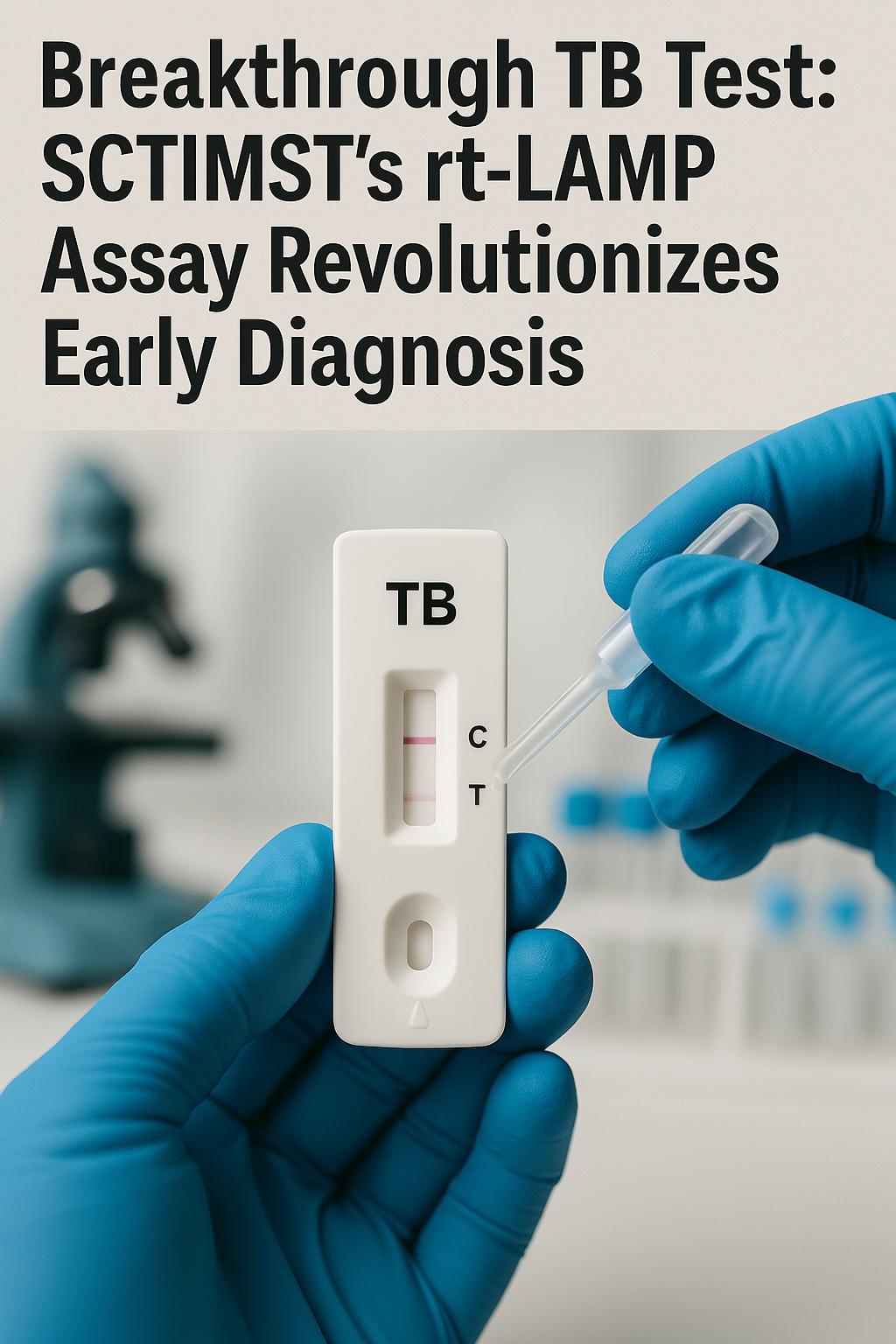Tuberculosis (TB) remains a global health challenge, but hope is on the horizon. Researchers at the Sree Chitra Tirunal Institute for Medical Sciences and Technology (SCTIMST) in Thiruvananthapuram have unveiled a game-changing tool: a cost-effective, real-time LAMP (rt-LAMP) assay for early TB detection. Unlike traditional methods, this molecular test is fast, sensitive, and affordable, rivaling giants like GeneXpert and Truenat. So, what makes this innovation stand out, and how could it transform TB diagnosis in India and beyond? Let’s explore its features, benefits, and potential to reshape healthcare.
What Is the rt-LAMP Assay?
First, let’s break it down. The rt-LAMP assay is a molecular test designed to spot TB DNA with remarkable precision. For instance, it can detect as few as 10 DNA copies per microliter in a sample, showcasing its high sensitivity. Meanwhile, its specificity ensures accurate results, reducing false positives. Much like GeneXpert and Truenat, it targets TB at the genetic level, but here’s the twist: it’s faster and cheaper.
Additionally, this assay operates at a single temperature, unlike RT-PCR tests that juggle three settings. As a result, it simplifies the process, making it easier to deploy in resource-limited settings. Plus, it uses a fluorescent dye, Syto 16, to track amplification in real-time—every minute, not just at the end. Consequently, positive results can emerge in just 10-20 minutes, a massive leap for timely diagnosis.
Overcoming Past Challenges
So, why hasn’t LAMP been a go-to for TB before? Traditionally, dyes used in LAMP tests inhibited reactions, leading to false negatives. However, SCTIMST researchers cracked this puzzle. By using Syto 16—a dye common in lab studies of cells and biological samples—they eliminated the interference. For example, Syto 16 binds to DNA without disrupting amplification, ensuring reliable outcomes.
Moreover, the rt-LAMP assay uses six primers compared to RT-PCR’s two. Because all six must bind to the DNA for amplification to start, the test’s specificity is exceptionally high. In fact, this multi-primer approach also speeds up amplification, delivering results faster than many alternatives. Therefore, this breakthrough sidesteps long-standing hurdles, paving the way for practical, real-world use.
How Does rt-LAMP Perform?
Now, let’s look at its track record. The rt-LAMP assay was rigorously tested on 350 presumptive pulmonary TB sputum samples between October 2019 to March 2020 and January 2023 to March 2024. Specifically, it was evaluated against a microbiological reference standard (MRS), GeneXpert, and smear microscopy. The results? Impressive.
For instance, rt-LAMP showed 89.36% sensitivity and 94.06% specificity compared to MRS, slightly outperforming GeneXpert. This means it’s highly effective at catching true TB cases while minimizing false positives. Additionally, its ability to detect low DNA levels makes it a powerful tool for early diagnosis, crucial for stopping TB’s spread. As a result, it holds promise for clinics needing quick, trustworthy answers.
Why It’s a Game-Changer for India
India faces a steep TB burden, with 2.55 million cases reported in 2023. Yet, diagnosis lags—79% of presumptive cases rely on sputum smear microscopy, a less sensitive method, while only 21% use molecular tests like GeneXpert. Why does this matter? Smear microscopy often misses early or low-bacteria cases, delaying treatment. Meanwhile, the National Strategic Plan (2017-2025) aims to shift toward molecular testing, but facilities grew only from 5,090 in 2022 to 6,496 in 2023—still short of the goal.
Here’s where rt-LAMP shines. For one, it’s affordable—using inexpensive primers and Syto 16, no costly probes needed. Furthermore, it’s an open-platform system, meaning existing RT-PCR machines can be repurposed by tweaking them to run at one temperature. In fact, it can process 96 or 384 samples in a single run, enabling high-throughput testing for busy labs. Consequently, it could help India scale up molecular diagnostics without breaking the bank.
Practical Benefits and Accessibility
Beyond performance, rt-LAMP’s design is a win for accessibility. For example, its single-temperature setup skips the complex thermal cycling of RT-PCR, making it viable in smaller clinics or rural areas. Also, since it repurposes existing machines, labs don’t need pricey new gear. This flexibility is key in places where infrastructure is limited.
On top of that, the test’s speed—10-20 minutes for positive results—means faster patient care. Imagine a village health center diagnosing TB in under half an hour, letting treatment start the same day. Plus, with no proprietary lock-in, the open-platform approach invites broader adoption. Therefore, rt-LAMP could democratize high-quality TB testing across diverse settings.
The Road Ahead
Excitingly, rt-LAMP is already on a fast track. The technology has been licensed to industry and approved by India’s Central Drugs Standard Control Organisation (CDSCO). Meanwhile, the Indian Council of Medical Research (ICMR) is validating it, and the WHO Health Technology Access Pool is reviewing it pending ICMR’s nod. These steps suggest a rollout could be near, potentially transforming TB diagnosis by late 2025.
However, challenges remain. Scaling production, training lab staff, and integrating rt-LAMP into existing systems will take effort. Still, its cost-effectiveness and compatibility with current infrastructure give it a head start. As Dr. Anoopkumar Thekkuveettil, the study’s corresponding author, notes, “This assay facilitates high-throughput testing,” a critical edge for India’s TB fight.
A Brighter Future for TB Diagnosis
In conclusion, SCTIMST’s rt-LAMP assay is a beacon of hope for tackling TB. With its high sensitivity, affordability, and lightning-fast results, it stands to outshine older methods like smear microscopy and even rivals like GeneXpert. Most importantly, its open-platform design and low cost could make advanced testing accessible to millions, especially in high-burden nations like India.
As validation wraps up and adoption grows, rt-LAMP might soon redefine how we catch TB early, saving lives one test at a time. Curious about its impact? Keep an eye on ICMR and WHO updates—this could be a turning point in global health. Here’s to faster, fairer TB care for all!

